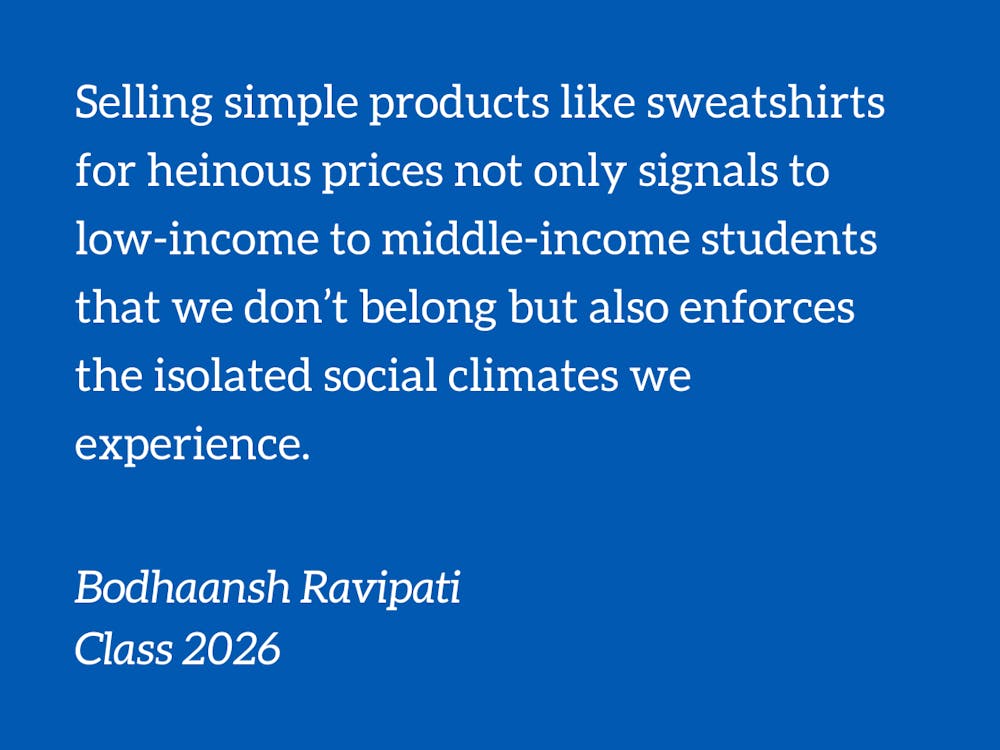Every spring, the university hosts Blue Devil Days — a program for accepted students to tour campus and for parents to say goodbye to their disposable incomes one last time. Though the program shut down during the pandemic, it has re-emerged with newfound vigor. Since the renewal of the two- to three-day program, our campus bustles with bright-eyed prospective first-years for weeks at a time in April and May. The most distinctive flavor of the events — aside from the notorious Chapel selfies — is a sea of t-shirts marked “Duke University - Class of 202X.” To some, this shirt is another layer on top of dozens of university branded sweatshirts, sweatpants, and sweaters. For others like me, this was the first piece of university merchandise we got. But for all, this little shirt is a symbol — one of acceptance, spirit and a lifetime of school loyalty. While the class shirt remains one of my favorites, it is one of dozens of university branded merchandise across campus, if not hundreds. And frankly, the class shirt is the only one many students can afford.
It is true. The founding fathers left out the right to “show school spirit” in the pursuit of happiness clause, which doesn’t really top anyone’s list of problems. I’ve always told myself that wanting fancy hoodies (and ) is the materialist in me — you can’t get joy from shirts with weird gothic fonts. But it can’t hurt right? If I want to snuff my midterm sorrows with “everyday tees” and “spirited crews,” I can get a few more prospective first-years to pay me for wrong directions.
So I went on a defiant walk to BC Plaza, grabbed the loudest, most branded jacket I could find, and checked the price tag. $170. The jacket was $170. While I’m sure inflation is terrible and supply chains are messed up, charging $170 for a piece of clothing is disgusting and grossly out of reach for most students. And yes, the store needs to make money and they offer a discount for enrolled students, but 15-20% is not nearly enough to make a $170 hoodie affordable for college students. For all their efforts to admit more low-income students and ease the transition to college, the university refuses to turn down a chance to milk their students for all they’re worth.
You might be thinking that if some students want to pay exorbitant prices, the university has no moral obligation to lower them. We live in a capitalist society, after all. Frankly, this is a simplistic interpretation. Sure, some students buy this stuff. Sure, the university has to make money. However, selling simple products like sweatshirts for heinous prices not only signals to low-income to middle-income students that we don’t belong but also enforces the isolated social climates we experience. If you want to know why you don’t see enough economic diversity in friend groups, it’s little stuff like this that makes socializing hard. No, merch prices aren’t why Duke is hard for low-income students, but they don’t help.
President Price wonders why students express dissatisfaction with the economic climate at Duke. He says we accept low-income students at levels comparable to other schools, and he’s right. So why do we feel the way we do? Because subtle cues like merch prices, food prices and club fees matter. They matter to us. The university’s economic climate has massive barriers to improvement, issues like admitting low-income students that are complex and time-intensive. And if the school wants to fix it, it has to put in the work. What it ignores is that to many of us, the subtleties matter too. So in the meantime, while the long-term fixes are found and implemented, focus on the small issues too. Throw us a few reasonably priced hoodies.
Bodhaansh Ravipati is a Trinity sophomore.
Get The Chronicle straight to your inbox
Signup for our weekly newsletter. Cancel at any time.

